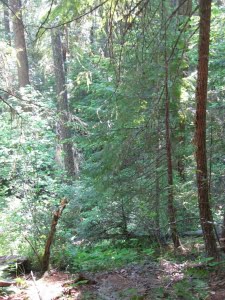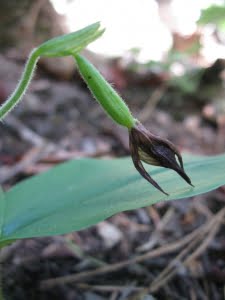
In Search of clustered lady’s slipper (Cypripedium Fasciculatum)
 |
| Clustered lady’s slipper habitat |
Clustered lady’s slipper (Cypripedium fasciculatum) is a member of the orchid family that occurs throughout the western states and it is one of only three members of the Cypripedium genus endemic to western North America. The Bureau of Land Management and the USDA Forest Service have listed the plant as a sensitive species, meaning that the population viability is of concern and the species may require active conservation. In Oregon, clustered lady’s slipper predominantly occurs within the Klamath mountain region in coniferous forests with steep slopes and dense canopy cover. The BLM has documented over 800 occurrences of clustered lady’s slipper in the Medford District, but many of the sightings were documented several decades ago. In order to create a more accurate understanding of the current population, the Institute for Applied Ecology has spent several years revisiting previously documented sites to determine the presence or absence of plants and the quality of the populations. Clustered lady’s slipper is a relatively small orchid and is identified by its hairy stem and sessile opposite leaves. A detailed species description can be found here.
The purpose of this project is to update sighting reports, some of which are 30 years old, with accurate information about the status of the previously documented populations. Many of the sites were initially discovered during pre-disturbance site surveys for proposed projects. In the last several years, IAE has predominantly surveyed for clustered lady’s slipper on BLM lands; in 2012, we focused our surveys on Forest Service sites which tend to occur at higher elevation than the BLM sites. Information gathered during these site visits will be used to update and reinforce predictions made with the Population ViabilityAnalysis and it could potentially be used to reevaluate the species’ listing.
 |
| Budding clustered lady’s slipper |
Since IAE began revisiting sites in 2008, 64 sighting reports from the BLM have been updated. To date in 2012, there have been 11 Forest Service sites updated, 3 of which had surviving populations of clustered lady’s slipper. All of the successful populations were situated on steep slopes with low understory cover and high canopy cover. Populations that have disappeared since the last sighting often occurred in areas where disturbance had been proposed, such as construction of mining pits, pathways, and timber access. Surveying will continue throughout the summer in an effort to collect data at as many Forest Service sites as possible.
The ongoing trend of population decline and local extinction of clustered lady’s slipper populations can be attributed to several causes. Firstly, the plants are threatened by habitat disturbance, such as mining, logging and maintenance of gas and power lines. Such disturbance can alter hydrological patterns and increase light exposure. Secondly, as the PVA has predicted, populations with fewer individuals have a greater risk of extinction. More than half of the documented populations in Oregon have fewer than ten plants, putting them at greater risk. Clustered lady’s slipper is a non-rewarding species, meaning that it is difficult to attract pollinators since there are no nectar benefits. In addition, there is little evidence of seedling recruitment. IAE will continue to revisit BLM and Forest Service sites working to update enough information to describe the current status of clustered lady’s slipper populations.
 |
| Cypripedium fasciculatum |
